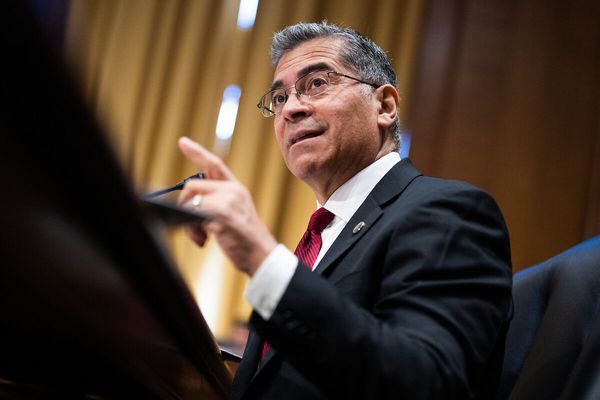
Through a flurry of executive orders, a newly inaugurated Donald Trump has made clear his support for the ascendancy of fossil fuels, the dismantling of support for cleaner energy and the United States’ exit from the fight to contain the escalating climate crisis.
“We will drill, baby, drill,” the president said in his inaugural address on Monday. “We have something that no other manufacturing nation will ever have – the largest amount of oil and gas of any country on Earth, and we are going to use it. We’re going to use it.”
Trump has promised to cut Americans’ energy costs in half within a year and he claimed removing all restraints on drilling for “liquid gold” will achieve this, even though the US is already producing more oil and gas than any other country in history.
Climate treaties, wind energy and electric vehicles are not part of this vision, with Trump signing orders to ditch or stymie them. Scientists say the world must urgently move away from fossil fuels to avoid the ever-worsening impacts of the climate crisis, as evidenced by last year being the hottest ever recorded and Los Angeles suffering ruinous wildfires.
It was a good day, though, for the fossil fuel executives who poured tens of millions of dollars into Trump’s election campaign. Some celebrated a few blocks away from the inauguration in Washington at a party where they sipped champagne and nibbled on pastries with Trump’s face on them.
The priorities of Trump’s first term are now explicit. “These performative acts show the pervasive influence that the fossil fuel industry will have in the United States over the next four years,” the former vice-president Al Gore noted.
Declaration of energy emergency
What it’s trying to do: Trump declared a “national energy emergency” on Monday – part of a spate of actions meant to boost the already-booming fossil fuel industry. Invoked under the National Emergencies Act, the order aims to unlock an array of executive powers to fast-track the production and distribution of energy.
The move came amid stated concerns about both high energy prices and a forthcoming surge in electricity demand due to new data centers. That includes ones being built by Meta and Amazon, whose founders both attended Trump’s inauguration. “Without immediate remedy, this situation will dramatically deteriorate in the near future,” the order says.
It claims to be a path to boosting national security and lowering energy prices, and directs the Departments of Defense, Interior and Energy to make a 60-day assessment of limits on the supply of fuel. Energy is “needed to protect the homeland”, it says.
Department heads must also “identify and exercise any lawful emergency authorities available to them” to facilitate the production and transport of energy, and submit recommendations for executive authorities that could prioritize energy projects to get them out faster, such as the cold war-era Defense Production Act, the order says.
Reaction and analysis: Trump’s long-awaited energy emergency outraged climate advocates. “There is no energy emergency,” said Manish Bapna, president and CEO of the green non-profit Natural Resources Defense Council. “There is a climate emergency.”
In the 1970s, regions of the US declared energy emergencies amid coal, oil and gas shortages driven by an oil embargo and price controls. The country faces no such shortage today.
In fact, the US is currently producing more oil and gas than any other country in the history of the world, and levels are still increasing. Though the order calls to remove barriers to increasing drilling, oil companies are already producing at record levels. Many may not want to up their production over fears that increased supply could suppress energy prices, and amid concern that global demand may be unreliable as China works to accelerate gas production.
What US fossil fuel interests do want, reporting shows, is for Trump to help increase domestic energy demand. Removing barriers to distribution, alongside Trump’s attacks on energy efficiency, could force Americans to pay for more fuel – in effect forcing them to pay more to keep the lights on.
“President Trump’s plan to keep the US hooked on fossil fuels under the guise of ‘energy dominance’ will line the pocketbooks of billionaires and fossil fuel companies,” said Ashfaq Khalfan, climate justice director at the charity Oxfam America.
The oil and gas industry donated more than $75m to Trump’s campaign.
Withdrawing from the Paris climate agreement
What it’s trying to do: The United States’ troubled relationship with other countries over the climate crisis has a new chapter. Trump has again initiated the exit from the Paris climate deal, a breakthrough effort by countries in 2015 to stem dangerous global heating.
Trump not only sees such agreements as pointless, given in his view that the climate crisis is a “giant hoax”, but that they are also unfair to the US. “These agreements steer American taxpayer dollars to countries that do not require, or merit, financial assistance in the interests of the American people,” the executive order on the Paris withdrawal states.
In fact, the Paris deal is a non-binding agreement to avoid the world hitting temperatures that would deliver disastrous heatwaves, floods and storms upon societies and economies already strained by extreme events. In joining just three other countries – Yemen, Iran and Libya – outside the Paris process, the world’s second-largest carbon emitter is walking away from this shared goal while also halting funding for poorer countries at most risk of climate-driven calamities.
Reaction and analysis: When Trump last removed the US from the Paris deal, in 2017, there were fears that global cooperation on climate would completely unravel. This didn’t happen, although governments continue to collectively fail to do enough to avert a future riven by horrendous impacts of global heating.
With global investment in renewable energy surging, there is little prospect that the shift away from fossil fuels will completely evaporate during Trump’s term, even if progress remains painfully slow. The US’s exit, though, will relieve pressure on major emitters, most notably China, to do more to cut planet-heating pollution at a critical juncture where scientists say deep reductions must occur. Aid for developing countries hit hardest by a crisis they did not create will have to come from elsewhere, too.
“Pulling out of the Paris agreement is an abdication of responsibility and undermines the very global action that people at home and abroad desperately need,” said Rachel Cleetus, policy director at the Union of Concerned Scientists, who called Trump’s decision a “travesty”.
Cancelling Biden climate policies
What it’s trying to do: In one fell swoop on Monday, Trump rescinded 78 Biden-era executive actions, ranging from efforts to mobilize a federal Covid-19 response to orders meant to combat gender discrimination. Also on the chopping block were several environmentally focused executive actions, including ones focused on climate-related financial risk, protecting the Arctic and boosting multilateral climate action.
One 2021 order sought to address the growing risk the climate crisis poses to the US economy. It directed government officials to push for “accurate disclosure of climate-related financial risk”, and called on regulators to consider measures to boost those disclosures.
Trump also overturned two of Joe Biden’s attempts to restrict fossil fuel development. One, which the former president put forth earlier this month, meant to withdraw swaths of the US coasts from future oil and gas drilling, including the entire US east coast, the eastern Gulf of Mexico, parts of the Pacific coast and portions of Alaska’s Bering Sea. Another 2023 order limited drilling in nearly 3m acres of the Arctic Ocean in the National Petroleum Reserve in Alaska, which Biden announced when he approved the controversial and highly polluting Willow oil development project.
Two other now rescinded orders, both from 2021, established an officeto help advance international climate cooperation, and called on officials to study and prepare for the impacts of the climate crisis on migration.
Reaction and analysis: Trump has long derided green policies and repeatedly called the climate crisis a “hoax”.
The president has been expected to derail progress to boost disclosure of climate risk, including not only the 2021 executive order, but also a 2024 move from regulators requiring large businesses to report their planet-warming emissions.
His moves to expand fossil fuel extraction were also hotly anticipated amid his calls on the campaign trail and inauguration speech to “drill, baby, drill”. In his first term, he rolled out an array of actions to lift restrictions on resource extraction, including in Alaska.
“As Trump returns to office, we’re witnessing the deadly price tag of fossil fuel industry control over our democracy,” said Elizabeth Bast, executive director of the research and advocacy group Oil Change International.
Though reports show thousands of drilling permits are currently going unused, Trump appears to be determined to expand opportunities for extraction. The moves have been met with ire from environmentalists. Andy Moderow, senior director of policy at the non-profit Alaska Wilderness League, called them a “slap in the face to science, the American public and Indigenous communities who seek land protections”.
Trump’s overturning of actions focused on multilateral green efforts and climate-related migration jibe with other day-one orders removing the US from the Paris agreement and declaring a border crisis to crack down on immigration, respectively.
Lifting LNG export restrictions
What it’s trying to do: In recent years, the export of gas, chilled and laden on to huge tankers, has surged in the US, primarily via new terminals that have sprung up along the Gulf of Mexico (or is that Gulf of America?) coastline.
Faced by activists who pointed to the huge cost to the climate, as well as local communities dealing with ruined fisheries and air pollution, Biden paused new permits for exports pending a review.
This Department of Energy review found that further growth in liquified natural gas (LNG) exports will raise electricity and gas costs for US households, as well as worsen the climate crisis.
Despite this, Trump has swept aside the pause on new exports, with his executive order bemoaning “burdensome and ideologically motivated regulations” that have hampered energy production. By one estimate, this should allow up to 14 planned terminals to go ahead, taking US gas around the world, primarily to Asia.
Reaction and analysis: The rationale for the LNG boom has been twofold: that it will supply much-needed gas to allies in Europe while helping other places, such as China, transition away from dirtier fuels like coal.
There is evidence that both of these assumptions are flawed, however, with Europe requiring far less gas than previously thought when Russia invaded Ukraine and research suggesting that freezing, shipping and then burning gas adds up to more carbon pollution even than coal.
Given the vast financial commitments and fluctuating markets involved in setting up LNG terminals, it is not clear if all the planned projects will come to fruition, but activists say that the costs will be borne by people in the US and overseas.
“The president’s decision to continue exporting LNG is deeply misguided,” said Gillian Giannetti, senior attorney at the Natural Resources Defense Council. “LNG operations contribute to dangerous climate pollution, harm public health and increase energy costs for American families – all while locking communities near those facilities into decades of environmental and economic risks.”
Boosting drilling in Alaska
What it’s trying to do: Trump paid special attention to Alaska, the largest state in the union by area, in his barrage of executive actions, demanding that Denali, the US’s tallest mountain, be renamed as Mount McKinley and issuing a separate order aimed at boosting drilling and logging across the state’s vast expanses.
Restrictions upon oil and gas development in the huge Arctic national wildlife refuge have been swept aside, a contentious 200-mile road through a wilderness area will be allowed to go ahead and limits upon logging activity in the Tongass national forest have also been nullified.
Capitalizing upon Alaska’s “extraordinary” natural resources will require an “immediate end to the assault on Alaska’s sovereignty and its ability to responsibly develop these resources for the benefit of the nation”, according to an order signed by Trump.
Reaction and analysis: The Arctic reaches of northern Alaska are warming up about three times faster than the global average, with the climate crisis warping the traditional way of life for many who live there.
Several Native groups have warned that further drilling will only worsen these impacts, as well as disrupt vital wildlife patterns such as the migration of caribou to coastal areas that are eyed by oil and gas companies. “Unfortunately, President Trump has made attacking these sacred lands a priority in his previous administration, and, unfortunately, it seems in his second,” said Kristen Moreland, executive director of the Gwich’in steering committee.
“The Gwich’in people stand in solidarity with all Alaska native communities and our allies that are opposed to extractive and destructive industry on sacred land. We will fight this.”
It’s unclear how much interest there will be in drilling in the frozen north, with a recent sale of leases in the Arctic national wildlife refuge yielding no bids. Yet some local groups, as well as Alaska’s Republican leadership, see a prosperous path opening up under the Trump administration.
“With his leadership, we can unlock Alaska’s vast potential to fuel the nation and create jobs for our people,” said Mike Dunleavy, Alaska’s governor.
Halting wind development
What it’s trying to do: Trump has long viewed wind energy with disdain, calling the sight of turbines “disgusting” and blaming them, misleadingly, for causing disproportionate deaths of birds and whales.
It was widely anticipated that Trump would try to halt the US’s nascent offshore wind sector after he repeatedly claimed turbines were killing whales, but the president’s executive order has gone further than this, placing a freeze on all permits for wind projects on both land and sea.
While almost all onshore wind is on private land, the executive order is enough to halt the Lava Ridge wind project in Idaho, which was plannedto be one of the largest of its kind in the US.
Wind is the largest single clean energy source in the US, supplying 10% of US power. The four biggest wind-producing states are all Republican-leaning – Texas, Iowa, Oklahoma and Kansas – meaning that Trump could face some localized discontent over the pause.
Reaction and analysis: While there is some organized dissent to the erection of towering wind turbines in rural areas and off the coasts, the energy source is popular with most Americans and has provided some farmers with welcome additional income.
Trump’s antipathy to what he calls “windmills” appears to run deep, however, and is shared by Robert F Kennedy Jr, his nominee for health secretary, who has waged an ongoing battle against offshore wind. A spate of whale deaths off the north-eastern US has been blamed by opponents on wind turbines, although experts say that shipping, fishing nets and the climate crisis remain the main threats to marine mammals.
The wind industry employs more than 125,000 people in the US and its representatives argue that Trump’s mantra of “energy dominance” appears inconsistent and wholly geared towards fossil fuels.
“No nation can achieve energy dominance absent consistent policy that moves beyond the idea that energy systems have partisan character,” said Jason Grumet, chief executive of the American Clean Power Association.
Axing efforts to boost EVs
What it’s trying to do: Trump took aim at federal support for electric vehicles, overturning a 2021 executive order aimed at making half of all new vehicles sold in 2030 electric.
“We will end the Green New Deal, and we will revoke the electric vehicle mandate, saving our auto industry,” he said in an address at the rotunda.
In an executive order, he also said his administration will halt the distribution of unspent government funds for vehicle charging stations and called for the end of a waiver for states to adopt stricter auto-emission rules by 2035.
The order also called for the end of a $7,500 consumer tax credit for EV purchases. The incentive was included in the Inflation Reduction Act of 2022, one of Joe Biden’s signature legislative achievements, which also included a $7.5bn plan to build EV-charging stations. And it signals the forthcoming rollback of auto pollution regulations finalized by Biden’s administration last spring, which Trump calls “EV mandate”, though they do not directly require the production of electric vehicles.
Reaction and analysis: Biden’s now rescinded order was not binding. It also won support from top US automakers.
The attacks on the electric vehicle industry could set off turmoil among manufacturers who have already invested billions in the transition away from gas-powered vehicles.
The moves could imperil US climate efforts. Transportation is the largest contributor to US planet-heating emissions and a major source of health-harming pollution.
“Rolling back vehicle emission safeguards harms our health, our wallets and our climate,” Katherine García, who directs the clean transit program at the green group Sierra Club, said.
Some of Trump’s attacks on electric vehicles may bypass Congress. Advocates are already exploring routes to have them overturned in the courts.
Trump thanked autoworkers in his inaugural speech, though the United Autoworkers – the country’s top union for the sector – backed Biden and then Harris in their presidential runs. In an op-ed on Monday, the head of the union critiqued the returning president, but sought common ground.







